The Fundamental Unit of Life
NCERT-CBSE-Class-9-Science-Chapter-5
Notes
|
Topics to be learn :
|
Cells are the basic fundamental, structural, and functional unit of living organisms, including plants and animals. They exist independently or in groups, performing all essential functions of life, making them the smallest unit of life.
What are Living Organisms Made Up of?
Discovery of Cell :
The invention of magnifying lenses made the discovery of single-celled microscopic organisms possible.
- Robert Hooke (1665) : He observed cork's honeycomb-like structures, called cells, under a primitive microscope. The term 'cell' comes from the Latin word 'cellula', meaning 'little room', and was derived from the honeycomb-like structure.
- Leeuwenhoek (1831) : Discovered the nucleus in the cell.
- Schleiden and Schwann (1838-1839) : Presented cell theory, which
- states that all plants and animals are composed of cells and that the cells are the basic unit of life.
- Purkinje (1839) : Coined the term 'protoplasm' for the fluid substance of the cell.
- Virchow (1855) : Expanded the cell theory by suggesting that all cells arise from pre-existing cells.
Cellular Composition in Different Organisms :
On the basis of the number of cells present, organisms are classified as unicellular and multicellular.
Unicellular organisms :
- Made up of a single cell.
- All life processes like digestion, respiration, etc. are performed by a single cell only.
- For example, Amoeba, Chlamydomonas, Paramecium, bacteria, etc.
Multicellular organisms
- Made up of many cells that are grouped together in a single body.
- All cells are specialised to perform different functions.
- For example, plants, animals and some fungi.
Each multicellular organism starts its life as a single cell (i.e. zygote) that divides to form many cells.
Division of Labour :
- Each living cell performs certain basic functions that are the characteristic of all living forms.
- To perform these functions, there is a division of labour in multicellular organisms which means that different parts of the human body perform different functions. For example, heart is made to pump blood, stomach to digest food, kidney to filter blood, etc.
- Division of labour is also seen within a single cell. Each cell has certain specific components within it known as cell organelles.
- These organelles perform a specific function, e.g. making new material in the cell, clearing waste material, etc. All these organelles together constitute the cell.
- Thus, a cell is able to live and perform all its functions because of these cell organelles.
Shape and Size of Cells
The shape and size of cells are related to the specific functions they perform.
- Some cells have fixed shape (e.g. most plant and animal cells), while some cells like WBCs and Amoeba keep changing their shapes.
- Fixed shaped cells may be of various types such as elliptical (e.g. fat cell), spherical (e.g. ovum), spindle-shaped (e.g. smooth muscle cell), knobbed thread (e.g. sperm), discoidal (e.g. RBC), elongated (e.g. nerve cell), etc.
- The size of cell varies significantly from the smallest cell of Mycoplasma (0.1-0.5 um) to very large egg cells of the Ostrich (18 cm). Longest cells of human body are the nerve cells, which may reach up to a length of 90 cm (motor neurons).
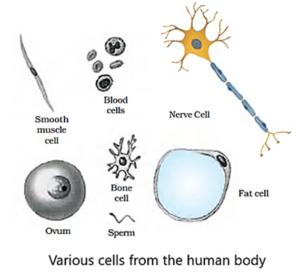
What is a Cell Made Up of? What is the Structural Organisation of a Cell? :
The microscopic studies revealed that every cell possesses three basic features in common, i.e.
- Plasma membrane : Outer covering of all cells. Plant cell also contains cell wall.
- Nucleus : Control centre of the cell.
- Cytoplasm : Contains cell organelles.
Due to the presence of these features, all activities inside the cell and interactions of the cell with its environment are possible.
Plasma membrane or cell membrane :
This is the outermost living, thin and delicate covering of a cell that separates the contents of the cell from its external environment.
The structure of the plasma membrane can only be observed through electron microscope. The plasma membrane is made up of organic molecules called lipids and proteins which provide flexibility to it.
Functions of Plasma Membrane :
- It allows the entry and exit of some selective materials in and out of the cell. The cell membrane therefore, acts as a selectively permeable membrane.
- It helps to maintain the shape of the cell.
- It acts as a mechanical barrier and protects the internal contents of the cell.
- The flexibility of a cell membrane enables cell to engulf in food and other materials from its external environment. This process is called endocytosis. For example, Amoeba acquires its food through this process, with the help of finger-like projections called pseudopodia.
Movement of Substances Across the Cell Membrane
Movement of substances across the cell membrane occurs by the process of diffusion and osmosis.
(1) Movement of a Substance by Diffusion :
The spontaneous movement of a substance (i.e. solid, liquid or gas) from a region of its higher concentration to a region of its lower concentration is called diffusion.
Examples :
- Some substances like CO2 (cellular waste, which needs to be excreted out) accumulates in higher concentration inside the cell. In the cell's external environment, the concentration of CO2 is low as compared to that inside the cell. Due to this difference in the concentration, CO2 moves out of the cell by the process of diffusion.
- Similarly, O2 enters the cell by the process of diffusion, when the level or concentration of O2 inside the cell decreases.
Significance :
The process of diffusion plays an important role in exchange of gases and water between the cells as well as the cell and its external environment.
(2) Transport of Substance Across the Membrane by Osmosis :
The process of osmosis involves the movement of water molecules from the region of its higher concentration towards the region of its lower concentration through a semipermeable membrane.
Examples :
- Unicellular freshwater organisms and most plant cells tend to gain water through osmosis.
- Plant roots absorb water by the process of osmosis.
The movement of water across the plasma membrane is affected by the amount of substance dissolved in water.
The process of osmosis can be seen in a cell placed in solution of different concentrations such as hypotonic, isotonic and hypertonic.
If we put an animal cell or a plant cell into a solution of sugar or salt in water, one of the following three things could happen:
(i) Hypotonic solution : The medium or solution surrounding the cell has a higher water concentration as compared to that inside of the cell.
- A cell placed in hypotonic solution gains water and swells up via endosmosis. This happens because the water molecules are free to pass across the cell membrane in both direction, but more water enters the cell than that leaving it.
(ii) Isotonic solution : The medium or solution surrounding the cell has exactly the same concentration of water as that present inside the cell.
- A cell placed in isotonic solution remains same in size. This is because there is no net movement of water, i.e. the amount of water going in is same as the amount of water going out.
(iii) Hypertonic solution : The medium or solution surrounding the cell has a lower concentration of water than the cell.
- A cell placed in hypertonic solution gets shrinked via exosmosis. This is because in this case also the water crosses the cell membrane in both directions, but more water leaves the cell than enters it.
Cell wall :
- The cell wall, a rigid, non-living covering found outside the plasma membrane in all plant cell, bacterial cell and fungal cells.
- The cell wall is absent in animal cells.
- When compared to cell membrane, the cell wall is freely permeable in nature.
- Cell wall is primarily composed of cellulose, a complex carbohydrate that provides structural strength to the plants.
Plasmolysis : When a living plant cell loses water through osmosis there is shrinkage or contraction of the contents of the cell away from the cell wall. This phenomenon is known as plasmolysis.
Functions of Cell Wall :
- It provides definite shape to the cell.
- It permits the cells of plants, fungi and bacteria to withstand very dilute or hypotonic external media without bursting. In hypotonic medium, the cells tend to take up water by osmosis. The cell swells up building pressure against the cell wall. The wall exerts an equal pressure against the swollen cell. Because of the presence of cell wall, these cells can withstand much greater changes in the surrounding medium than animal cells.
- It protects the cell by providing structural and mechanical strength.
Nucleus :
A nucleus is a spherical or oval structure present inside the cell. It is popularly called as the brain of cell.
Structure of Nucleus :
(i) Nuclear membrane : It is the outer, double-layered covering that has numerous pores called nuclear pores that allow the transfer of materials from inside the nucleus to the cytoplasm.
(ii) Nucleoplasm : It is a liquid ground substance encloses by a nuclear membrane. It contains nucleolus and chromatin material.
(iii) Nucleolus : It is a more or less round structure found inside the nucleus. It does not have a covering or membranes. It is known as the factory of ribosomes.
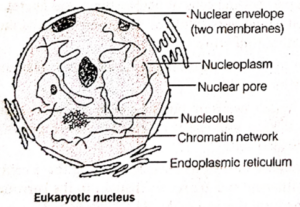
(iv) Chromatin : It is an entangled network of long, thread-like structures. It condenses to form chromosomes during cell division. These chromosomes appear as rod-shaped structures and are visible only when the cell is about to divide.
They contain information for the inheritance of characters or features from parents to next generation in the form of DNA molecules. Chromosomes are composed of two components, (i.e. DNA and protein). The DNA molecules contain information necessary for constructing and organising cells. The functional segments of DNA are called genes.
Functions of Nucleus :
- Nucleus plays essential role in cellular reproduction. In this process, a cell divides to form two new cells.
- It determines the cell development and maturity by directing the chemical activities of the cell.
- It helps in the transmission of hereditary traits from parents to offspring.
- It controls all metabolic activities of the cell.
Prokaryotic and Eukaryotic Cell :
On the basis of complexity of cell structure and the absence or presence of true nucleus, cells can be classified into following two types
Prokaryotic Cells : (Gr. Pro-Primitive or primary; karyos-nucleus)
- These cells contain primitive unorganised nucleus which is not bounded by any membrane. In some organisms like bacteria, the nuclear region of the cell is poorly defined because of the absence of nuclear membrane.
- The nuclear region in these organisms contains only nucleic acids. Such an undefined nuclear region is called nucleoid, and organisms whose cells lack a nuclear membrane are called prokaryotes.
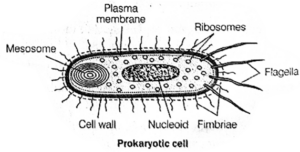
The prokaryotes also lack most of the cytoplasmic organelles. Many of the functions of such organelles are thus performed by the poorly developed parts of cytoplasm.
For example, the chlorophyll in photosynthetic prokaryotic bacteria is associated with membranous vesicles (bag-like structures) or lamellar structures, but not with plastids because plastids are not observed in it as in photosynthetic eukaryotic plant cells.
Eukaryotic Cells : (Gr. Eu-Advanced; karyos-nucleus)
These cells which possess a well-defined membrane bound nucleus are called eukaryotic cells. These organisms have cells having a well-defined nucleus as well as membrane enclosed organelles.
The eukaryotic cells are further categorised into plant and animal cells. These are also different from each other in many ways.
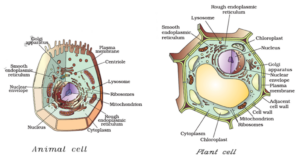
Differences between Prokaryotic and Eukaryotic Cells :
Prokaryotic and eukaryotic cells are the two main types of cells that make up living organisms. Here are the key differences between them:
| Feature | Prokaryotic Cells | Eukaryotic Cells |
| Nucleus | No true nucleus; DNA is in a nucleoid region | True nucleus enclosed by a nuclear membrane |
| DNA Structure | Circular, single-stranded DNA | Linear, multiple chromosomes |
| Organelles | No membrane-bound organelles | Membrane-bound organelles (e.g., mitochondria, ER, Golgi apparatus) |
| Size | Small (0.1–5 µm) | Larger (10–100 µm) |
| Complexity | Simpler structure | More complex structure |
| Cell Division | Binary fission | Mitosis or meiosis |
| Ribosomes | Smaller (70S) | Larger (80S) |
| Cell Wall | Present (made of peptidoglycan in bacteria) | Present in plants and fungi (made of cellulose or chitin), absent in animal cells |
| Examples | Bacteria, Archaea | Animals, plants, fungi, protists |
Cytoplasm :
It is the fluid content present inside the plasma membrane. It contains many specialised cell organelles, each of which performs a specific function for the cell.
Functions of Cytoplasm :
It perform the following functions
- It helps in the exchange of material between cell organelles.
- It acts as a storehouse of vital molecules such as amino acid, glucose, vitamin, iron, etc.
- It acts as the site for certain metabolic pathways.
Cell organelles :
- Membrane-bound organelles are microscopic structures that perform specific functions for cells.
- Large and complex cells require numerous chemical activities to maintain their structure and function.
- These membrane-bound structures separate these activities, distinguishing eukaryotic cells from prokaryotic cells.
- Some of these organelles are only visible with an electron microscope.
(i) Endoplasmic reticulum (ER) :
- It is a large network of membrane-bound tubes and sheets extending from outer nuclear membrane into the cytoplasm.
- The ER looks like long tubules or round or oblong bags (vesicles). It occurs in three different forms, such as cisternae, vesicles and tubules.
- The membrane of endoplasmic reticulum is similar in structure to the plasma membrane.
Types of Endoplasmic Reticulum
Depending upon the nature of its membrane, ER is divided into main two types
(i) Rough Endoplasmic Reticulum (RER) : It contains ribosomal particles on its surfaces due to which its surface appears rough. RER is mainly formed of cisternae.
(ii) Smooth Endoplasmic Reticulum (SER) : Its surface is smooth due to the absence of ribosomes. It is formed of vesicles and tubules.
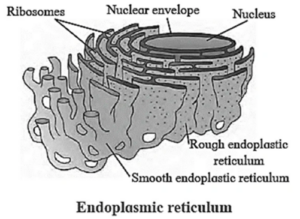
Functions of endoplasmic reticulum :
- Ribosomes in active cells act as protein synthesis sites.
- SER aids in the production of fat molecules or lipids crucial for cell function.
- Some proteins and lipids aid in membrane biogenesis.
- SER synthesises other proteins and lipids as enzymes and hormones.
- SER is vital in detoxifying poisons and drugs in vertebrates' liver cells.
- ER forms a network system providing channels for proteins and transporting materials.
- Functions as a cytoplasmic framework, providing a surface for cell biochemical activities.
- Provides mechanical support to cells.
(ii) Golgi apparatus :
- It is a membranous structure which arises from the membrane of smooth ER. It was first described by Camillo Golgi.
- It consists of a system of a membrane- bound, fluid-filled vesicles, large spherical vacuoles and smooth, flattened sacs called cisternae. These are stacked parallel to each other. Each of these stacks is called a cistern.
- These membranes have connections with the membranes of ER and therefore, constitute another portion of a complex cellular membrane system.
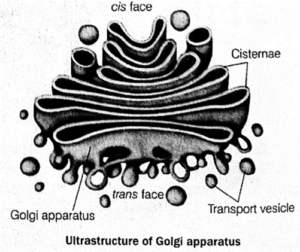
Functions of the Golgi apparatus :
- Golgi apparatus stores, modifies and packs products in vesicles. The material that is synthesised near Endoplasmic Reticulum (ER) is packaged and dispatched to various parts of the cell through Golgi apparatus.
- It is also involved in the formation of lysosomes.
- In some cases, it also forms complex sugars from simple sugars.
| Know This :
Black Reaction by Camillo Golgi Camillo Golgi, born in 1843, was a renowned scientist known for his groundbreaking work on the nervous system. His most notable discovery was the 'black reaction' method, which uses a weak silver nitrate solution to stain individual nerve and cell structures. This groundbreaking technique, which involved tracing delicate cell ramification, earned Golgi the Nobel Prize in 1906 alongside Santiago Ramón y Cajal for their groundbreaking work on the nervous system's structure. |
(iii) Lysosomes :
- These are membrane bound sacs filled with digestive enzymes which are made by rough endoplasmic reticulum.
- These enzymes are capable of breaking. down all organic materials. Lysosomes are present in all animal cells except mammalian RBCs.
Important functions of Lysosomes :
- These are a kind of waste disposal system of the cell thus, help to keep the cell clean by digesting old and worn-out cell organelles.
- They also protect the cells from infections. The foreign materials entering the cell, such as bacteria, end up in the lysosomes and get destroyed.
- During the disturbance in the cellular metabolism, e.g. when the cell gets damaged, lysosomes may burst and the enzymes digest their own cell. Therefore, lysosomes are also known as the suicidal bags of the cell.
(iv) Mitochondria :
- It is small rod-like or spherical structure present in the cytoplasm. It was first observed by Kolliker in 1857.
- These are important cell organelles involved in aerobic respiration. Mitochondrion is known as the power house of the cell.
Structure :
- It is a double membrane bounded cell organelle.
- The outer membrane is porous while the inner membrane is deeply folded into finger-like projections called cristae.
- These folds helps to increase the surface area for ATP generating chemical reactions.

Functions :
- Mitochondria helps to generate energy for various chemical activities in the cells. It is therefore known as the powerhouse of the cell. It releases energy required by the cell in the form of ATP (Adenosine Triphosphate). This ATP is known as energy currency of the cell. The ATP released by mitochondria is used by the body for making new chemical compounds and for other mechanical work.
- Mitochondria are the strange organelles in the sense that they have their own DNA and ribosomes. Hence, they are able to make some of their own proteins.
(V) Plastids :
- These are oval or discoidal double membrane bound organelle.
- Plastids are found only in plant cells.
- The internal organisation of plastids contains numerous membrane layers embedded in a material called stroma.
- These are similar to mitochondria in external structure.
- Like mitochondria, plastids also contain their own DNA and ribosomes.
Types of Plastids :
Plastids are classified according to the pigments present in it. Three main types of plastids are - leucoplasts, chromoplasts and chloroplasts.
(i) Leucoplasts do not contain any photosynthetic pigments they are of various shapes and sizes. These are meant for storage of nutrients.
- Amyloplasts store starch.
- Elaioplasts store oils. .
- Aleuroplasts store proteins.
(ii) Chromoplasts contain pigments like carotene and xanthophyll etc.
- They impart yellow, orange or red colour to flowers and fruits.
- These plastids are found in the coloured parts of flowers and fruits.
(iii) Chloroplasts are plastids containing green pigment chlorophyll along with various yellow and orange pigments and other enzymes that help in production of sugar by photosynthesis.
- They are present in plants, algae and few protists like Euglena.
- These are important for photosynthesis in plants. Therefore, these are known as the kitchen of cells.
(vi) vacuoles :
- These are membrane bound storage sacs for solid or liquid contents. The membrane surrounding the vacuole is called tonoplast.
- In plant cells, the vacuoles are full of fluid from inside known as cell sap. It is a watery substance containing amino acids, minerals, protein, sugar, etc.
- Vacuoles are small-sized in animal cells, but in plant cells they are large-sized. The central vacuoles of some plants may occupy 50-90% of the total cell volume.
Functions of vacuoles :
- Vacuoles provide turgidity and rigidity to cells in plants.
- Many substances like amino acids, sugars, organic acids and proteins are stored in vacuoles.
- In Amoeba, consumed food items are stored in food vacuoles.
- In some unicellular organisms, vacuoles also play an important role in expelling excess water and some wastes from the cell.
Cell Division :
It is the process of formation of new cells from the pre-existing cells. Cell division is of two types
(1) Mitosis or Mitotic Cell Division :
The process of cell division by which most of the cells divide for growth is called mitosis.
- The dividing cells are called mother cells which form two identical daughter cells. Each daughter cell has same number of chromosomes as that of mother cell.
Significance of Mitosis :
- It helps in growth and repair of tissues in organisms.
- It helps to replace old, dead and injured cells.
(2) Meiosis or Meiotic Cell Division :
The process of cell division by which specific cells of reproductive organs or tissues in animals and plants divide to form gametes is called meiosis.
- The male and female gametes after fertilisation give rise to offspring. When a cell divides by meiosis, it produces four new cells instead of just two.
- The process of meiosis occurs in two stages, i.e. meiosis-I and meiosis-II.
- In meiosis-I, the germ cells divide into two daughter cells which have only half number of chromosomes in comparison to mother germ cells. In contrast to meiosis-I, meiosis-II resembles a normal mitosis.
Significance of Meiosis
- It results in the formation of gametes which after fertilisation give rise to offspring.
- It maintains the diploid number of chromosomes in the offspring.

Click on below link to get PDF from store :
PDF : NCERT-Class-9-Science-Chapter-5-The Fundamental Unit of Life - Notes
PDF : NCERT-Class-9-Science-Chapter-5-The Fundamental Unit of Life - Solution
Main Page : NCERT-Class-9-Science – All chapters notes, solutions, videos, test, pdf.
Previous Chapter : Chapter-4-STRUCTURE OF THE ATOM – Online Notes
Next Chapter : Chapter-6- TISSUES – Online Notes
